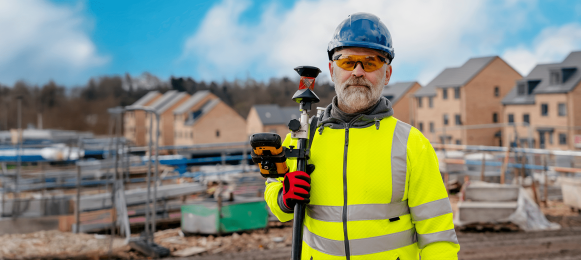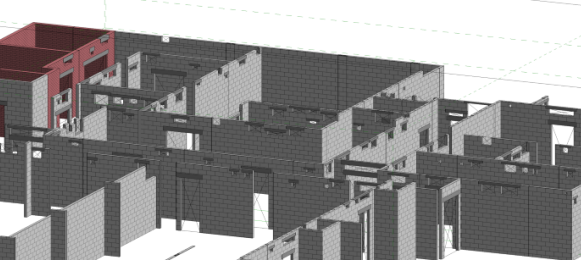A point cloud survey is a process that uses laser scanning technology like 3D laser scanning or photogrammetry to capture vast amounts of 3D data from a physical object or space. The output is a "point cloud," a collection of millions of data points, each with a precise X, Y and Z coordinate. Its main benefits are its speed and the significant amount of data it captures. However, for the technology to be truly useful, it must also deliver accurate data, a key factor in deciding whether laser scanning technology is suitable for a specific building survey or project.
Understanding Point Cloud Survey Uses and Benefits
A point cloud survey is like taking a very detailed picture of a room with millions of tiny dots, each perfectly placed. The reason professionals such as architects and surveyors use this technology is because it's much faster than traditional surveying methods and provides an incredible amount of information. Using 3D laser scanners, surveyors can collect extremely accurate data about on-site conditions in a fraction of the time it takes with ground-based surveying techniques. But if those data points are not in the right places, the 3D representation is not useful for building something precisely. So, whilst speed and detailed data are great, the real value comes down to accuracy.
The potential for sub-centimetre accuracy and high accuracy is often cited as the reason for using point cloud surveys, but real-world results vary. The most significant factors affecting a measured building survey's precision include the laser scanning equipment used, environmental conditions and the complexity of the object being scanned. Point clouds can be used across various surveying services, from creating a digital twin to supporting 3D BIM workflows.
Laser Scan Equipment and Survey Methodology: Choosing the Right Tools
Understanding the benefits of point cloud surveys starts with knowing which laser scanners are available:
Terrestrial Laser Scanners (TLS): These are typically the most accurate, capable of capturing millions of data points with precision of a few millimetres. They work by using a line of laser light that sweeps across surfaces, with the laser beam returning to the scanner to calculate distances. Fixed on a tripod from a single vantage point, they eliminate movement and allow for dense, high-quality scans. Laser scanners can capture significantly higher volumes of data compared to traditional surveying methods. However, even with TLS, the final point cloud can have errors if the alignment, or "registration", is not within set tolerances. The number of scans required depends on project complexity.
Photogrammetry: This method uses overlapping photographs to create a 3D model. Its accuracy is generally a few centimetres, making it suitable for larger-scale mapping where extreme detail is not the primary requirement. The raw data can be processed using CAD and BIM software.
Mobile and Drone-Based Scanning: Whilst offering incredible speed and coverage, handheld mobile scanners and drones generally have lower accuracy tolerance compared to static TLS. These surveying methods are ideal when the time it takes to complete internal and external surveys needs to be minimised.
Environmental Factors Affecting Laser Scanning Survey Data Points
The survey equipment being used is only part of the equation. Material, colour and reflectivity of surfaces can significantly impact accuracy. Dark or highly reflective surfaces, like glass or polished metal, can be challenging for 3D laser scanners to scan, leading to "noise" or missing data. This affects the collected data quality and means surveyors need to think about what the data will be used for when planning scan locations.
Atmospheric conditions such as rain, fog, or even strong sunlight can interfere with laser beams, reducing the quality of laser scanned data collected. Furthermore, distance and angle are crucial. Greater distance from the scanner to the object can result in less dense data and higher potential for error. The scanner's position and density settings affect whether there is enough data to create comprehensive data sets for the project's requirements.
Point Cloud Survey Accuracy in Practice: From Scan Data to Revit Models
Whilst a terrestrial laser scanner can achieve sub-centimetre accuracy in controlled settings, a sizable 3D point cloud of a large, multi-storey building may show registration errors in the range of a few centimetres. These systematic errors can cause misalignments between different portions of the point cloud. Therefore, it's critical to perform independent validation, such as using scan data or reference geo-coordinate systems from a total station control survey, to verify the survey data's accuracy before downstream applications.
At AJ Digital, we understand that using a point cloud survey effectively means transforming raw scan data into actionable information. Our laser scanning services include processing the collected data and converting it into detailed 3D models using Revit and other BIM software. This process, known as Scan to BIM, creates a detailed 3D digital representation that architects, engineers and contractors can use for design coordination and construction planning. The comprehensive data captured through laser surveys provides unparalleled accuracy for both internal and external building elements.
Point Cloud Survey Cost and the Benefits of Point Cloud Technology
Understanding point cloud survey cost factors is essential for project planning. The benefits of point cloud surveys often outweigh the initial investment when you consider the reduction in the need for site revisits and the accuracy of the data provided. Using 3D laser scanning technology to capture millions of data points in a single visit eliminates many inefficiencies associated with traditional surveying methods.
Laser scanning costs include factors such as the number of scans required, site complexity, processing time needed and the final deliverables required, whether that's plans and 3D models, CAD drawings, or full BIM integration. The surveying industry has seen laser scanning become increasingly cost-effective as technology has matured. Many projects find that the time saved and detailed 3D information provided justify the investment, particularly when the potential of point cloud surveys is fully utilised through services like information management and digital coordination.
Measured Building Survey Accuracy Requirements for Different Applications
A point cloud's accuracy is best measured against specific project requirements. For intricate architectural details on a heritage building, millimetre-level detail is essential. The 3D point data must be precise enough to capture ornate features and subtle variations. However, for large-scale topographical surveys or preliminary site planning using land surveying techniques, centimetre-level accuracy may be sufficient. The level of detail required directly influences time spent on-site, the survey equipment used and subsequent data processing, all of which impact the project's overall cost and timeline.
Using a point cloud effectively means understanding how the data will be used. For architects working on renovation projects, the survey allows for precise measurement and verification of existing conditions. For contractors, using 3D laser technology means they can verify as-built conditions and reduce the risk of costly clashes during construction.
The Value of Expert 3D Laser Surveying Services and Laser Scanned Data
A point cloud survey offers a significant leap forward in precision and efficiency over traditional manual methods. It virtually eliminates the need for multiple site visits and reduces the risk of human error in data collection. Used to deliver 3D models and BIM-ready data, point cloud surveys have become an essential tool in modern construction and facility management.
However, its accuracy is not absolute. A successful laser scanning survey relies on a skilled operator who understands the interplay of equipment, environment and geometry to produce a data set that is highly detailed and fit for its intended purpose. At AJ Digital, our experienced team ensures that every point cloud survey delivers the accuracy and detail your project requires, from initial capture through to final deliverables in Revit, CAD or other formats.
The potential of point cloud surveys continues to expand as technology evolves. From creating digital twins for asset management to supporting complex design coordination projects, using 3D laser scanners provides a foundation of comprehensive data that drives better decision-making throughout the project lifecycle. By choosing experienced surveying services providers like AJ Digital, you ensure that your project benefits from both cutting-edge technology and the expertise needed to transform raw scan data into valuable project insights.
Whether you're planning a measured building survey for a heritage project, need accurate as-built data for a renovation, or require detailed 3D models for new construction, understanding the accuracy and capabilities of point cloud surveys helps you make informed decisions about your project's surveying needs.
Contact us to discuss how our laser scanning technology can support your next project.



